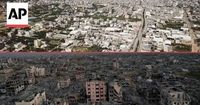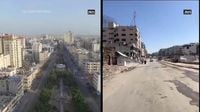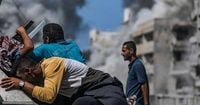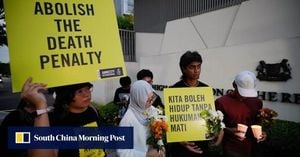On a sweltering September morning in 2025, the border fence separating Israel from Gaza became the unlikely stage for a profound national reckoning. Dozens of Jewish Israeli activists, braving the heat and the weight of public disapproval, marched toward the barrier—not as soldiers, but as dissenters. Their message was unambiguous: end the siege being carried out in their name. According to CNN, the activists, though a minority, demanded the international community sanction and isolate Israel, calling for the world to "stop the genocide and end the decades-long Zionist apartheid regime."
"We are fully aware that the government is not going to stop, so we are here to call on the world to boycott us, as ridiculous as it sounds," activist Sapir Sluzker Amran told CNN. She added, "It’s a shame that we don’t have more people with us today, but I think we need to keep challenging our own society. … They’re in denial, and I think the best way to get out of this denial is to keep shocking them until everyone faces the horrible truth that we are committing genocide."
The activists’ protest came just weeks after an independent United Nations inquiry concluded, for the first time, that Israel had committed genocide against Palestinians in Gaza—a finding Israel’s government has firmly rejected. The divide in Israeli society is stark. In Sderot, a city frequently targeted by rocket fire and attacked on October 7, 2023, some Israelis have turned the devastation in Gaza into a spectacle. CNN describes the so-called "Sderot cinema," where onlookers watch the bombardment through tower viewers, some bringing snacks and snapping selfies as airstrikes thunder in the distance. "When I look at Gaza from here and see buildings still standing, it makes me upset. … I want Israel to continue until it’s all flattened," said Rafael Hemo, one observer. He continued, "After what we’ve gone through, they need to be gone. No more Gaza."
The October 7, 2023, Hamas-led attack, which killed 1,200 Israelis and resulted in more than 250 hostages, remains a defining moment. Nearly two years on, 48 hostages are still in Gaza, with only 20 believed to be alive. For many Israelis, this event is seared into the national psyche—Israel’s own 9/11. Until the hostages are returned and the circumstances fully understood, there is little appetite among much of the public to contemplate the suffering on the other side.
Yet, the devastation in Gaza is impossible to ignore for those living through it. Palestinian poet Fedaa Zeyad, who resisted fleeing her temporary home in Shati refugee camp as long as she could, described the relentless bombardment and ground shaking as Israeli forces pounded Gaza City in early September 2025. According to The Irish Times, when the bombing reached her street, Zeyad joined the exodus of hundreds of thousands heading south, seeking refuge in the relatively undamaged town of Deir al-Balah. "If I ever go back, it will not be the same city I have known. Already much of it has been erased and obliterated," she said.
The scale of destruction in Gaza is staggering. Over two years of Israeli bombardment and repeated ground incursions have reduced large swathes of the enclave to rubble, wrecked its agricultural land, and shattered food systems. A recent UN assessment cited by The Irish Times found that 78% of buildings in Gaza have been damaged, with more than half completely destroyed. Almost all cropland is either inaccessible or ruined, and 90% of schools have been damaged or destroyed. Not a single university remains standing, leaving students with no clear path to resume their education.
The humanitarian crisis has reached catastrophic levels. More than 66,000 Palestinians have been killed since the war began, according to local health authorities. Over 400 have died of malnutrition, and in August 2025, the Integrated Food Security Phase Classification (IPC), a UN-backed panel, declared famine in Gaza’s governorate. The UN Food and Agriculture Organization (FAO) reported that 98.5% of cropland is either damaged or inaccessible, and only 232 hectares of the pre-war 15,000 hectares remain cultivable. Livestock has been decimated, with just 1.4% of poultry and 3.8% of cattle surviving.
For many, the trauma is compounded by repeated displacement. Aid officials estimate that more than 80% of Gaza’s territory is now under Israeli military exclusion zones or forced displacement orders. In central and southern Gaza, vast numbers of people live in tents without basic services like running water or sanitation. The World Bank estimated the recovery and reconstruction cost for just the first year of the war at $53 billion, a figure that has only grown as the destruction continues.
Efforts to end the conflict have so far yielded little. In late September, the United States proposed a ceasefire and postwar plan, supported by Israel and Arab states. The plan, conditioned on Hamas disarming, envisions a "board of peace" to oversee Gaza’s administration. Hamas broadly agreed to the proposal and expressed willingness to free the remaining hostages. Yet, even if the plan is adopted and a ceasefire holds, UN officials warn that clearing the estimated 54 million tonnes of concrete debris and rebuilding Gaza’s infrastructure could take years and cost billions.
The war’s impact reverberates within Israeli society as well. While thousands protest weekly in Tel Aviv for the return of hostages and an end to the war, the killing of more than 66,000 Palestinians is rarely mentioned. According to a July 2025 poll by the Israel Democracy Institute, 79% of Jewish Israelis said they were not troubled by reports of famine and suffering among Palestinians in Gaza, whereas 86% of Arab respondents reported being troubled.
Media coverage has played a significant role in shaping public perception. Dr. Ayala Panievsky, an Israeli researcher, told CNN that since October 7, mainstream media has participated in a campaign of "dehumanization" of Palestinians, often erasing their voices and focusing coverage on Israeli soldiers rather than Palestinian suffering. Her soon-to-be-published report found that only 3% of Channel 12’s reports during the first six months of the war showed human suffering in Gaza. The 2025 World Press Freedom Index by Reporters Without Borders noted that press freedom and media plurality in Israel have been increasingly restricted since the start of the war.
For Gazans, the future is shrouded in uncertainty. With so much of their homeland destroyed and the prospect of rebuilding daunting, many fear permanent displacement. "We just need to forget the future for now because all avenues appear blocked," said Shahd Ghassan, a dentistry student. The trauma, hunger, and destruction have left a society struggling to survive—and to imagine what comes next.
As the world watches, the devastation in Gaza and the divisions within Israel show no sign of easy resolution. The war has not only transformed the landscape of Gaza but has also left deep scars on both societies, raising urgent questions about justice, accountability, and the possibility of peace.






